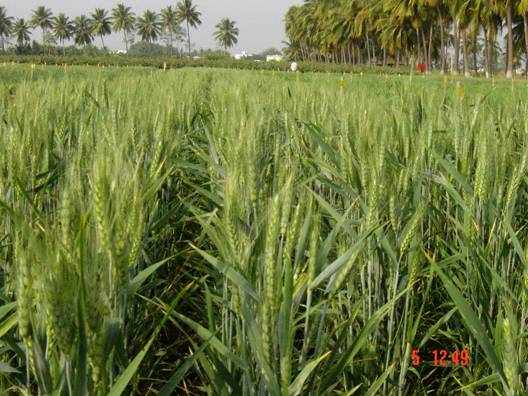Crop Production :: Wheat
WHEAT (Triticum aestivum.)
| Directorate of Wheat Research, Karnal | ||
| Directorate of Wheat Development |
CROP IMPROVEMENT
SEASON AND VARIETY
Suitable districts
Plains & adjoining areas near to hills and hills in Theni, Dindigul, Karur, Coimbatore, Erode, Salem, Dharmapuri, Vellore, Thiruvannamalai and Kancheepuram Districts
Season
Ideal sowing time is 15th October to 1st week of November. Sowing must be completed within the first fortnight of November.
Variety : COW(W)1, TNAU Samba Wheat COW 2
2. Morphological Description of COW(W) 1 and TNAU Samba Wheat COW
| Particulars | COW (W) 1 | COW (W) 2 |
| Parentage | HD2646/HW2002A/CPAN3057 | Mutant of NP 200 |
| Duration (days) | 85-90 | 110 |
| Grain yield (Kg /ha) | 2364 | 4040 |
| Stem | Erect | Erect to semi erect |
| Height (cm) | 73 – 78 | 75-80 cm |
| Tillers | 5-6 | 10-12 |
| Days to 50% flowering | 50 days | 73 days |
| Ear size and shape | Fusiform ears | Long & slightly tappering |
| Grain colour | Amber | Raddish |
| 1000 grains weight (g) | 37 | 41 |
| Special features | Non lodging, non shattering; tolerance to stem and leaf rust ; suitable for chappathi and bread making. | Resistant to rust, heat tolerant |
 Wheat - COW (W) 1 |  TNAU - Samba Wheat COW2 |
CROP MANAGEMENT
1. FIELD PREPARATION
Plough twice with an iron plough and two to three times with cultivator and prepare the land to a fine tilth.
2. APPLICATION OF FYM OR COMPOST
Spread 12.5 t/ha of FYM or compost on the unploughed field.
3. SEED TREATMENT WITH FUNGICIDES
Treat the seeds with Carbendazim or Thiram at 2 g/kg of seeds 24 hours before sowing.
4. FORMING BEDS AND CHANNEL
Form beds of size 10 m2 or 20 m2. The irrigation channels are to be provided sufficiently.
5. APPLICATION OF FERTILIZERS
- Apply NPK fertilizer as per soil test recommendation as far as possible. If soil test recommendation is not available, adopt a blanket recommendation of 80:40:40 NPK kg/ha.
- Apply half of N and full dose of P2O and K2O5 basally before sowing and incorporate in the sowing line.
SEED RATE: 100 kg/ha
6. SOWING
Draw the lines 20 cm apart and sow the seeds continuously after application of fertilizers to a depth of 5 cm. Avoid deep sowing.
7. WEED MANAGEMENT
- Spray Isoproturon 800 g/ha as pre-emergence spraying 3 days after sowing followed by one hand weeding on 35th day after sowing.
- If herbicide is not applied, give two hand weedings on 20th and 35th day after sowing.
8. WATER MANAGEMENT
The crop requires 4 - 6 irrigations depending on the soil type and rainfall. Wheat crop requires minimum of 5 irrigations at the following critical stages.
I – Immediately after sowing
II – Crown root intiation : 15-20 DAS
III- Active tillering stage : 35-40 DAS
IV- Flowering stage : 50-55 DAS
V- Grain filling stage : 70-75 DAS
Crown root initiation and flowering are the most critical stages. Water stagnation should be voided at the time of germination.
I – Immediately after sowing
II – Crown root intiation : 15-20 DAS
III- Active tillering stage : 35-40 DAS
IV- Flowering stage : 50-55 DAS
V- Grain filling stage : 70-75 DAS
Crown root initiation and flowering are the most critical stages. Water stagnation should be voided at the time of germination.
9. TOP DRESSING
Apply remaining half of N at crown root initiation stage (15-20 DAS).
10. HARVESTING
Harvest the crop when the grains become hard and straw becomes dry and brittle. Trash and winnow the grains. Use mechanical threshers to reduce the cost of threshing and winnowing.
11. CROP PROTECTION
Seed treatment: Treat the seed with any one of the following fungicides Carbendazim @ 2 g/kg of seed, Thiram @ 2 g/kg of seed or Carboxin @ 2 g/kg of seed.
12. POST HARVEST TECHNOLOGY IN WHEAT
Wheat is used principally for human consumption. It is converted into flour for the production of bread and other bakery products. It is used as “chapatti” (unleavened pan baked bread) in India. Wheat belongs to the genus Triticum and there are over 30,000 species and varieties. The principal wheats of commerce are the common or bread wheat (T.aestivum); macaroni wheat (T.durum) and club wheat (T.compactum).
No comments:
Post a Comment